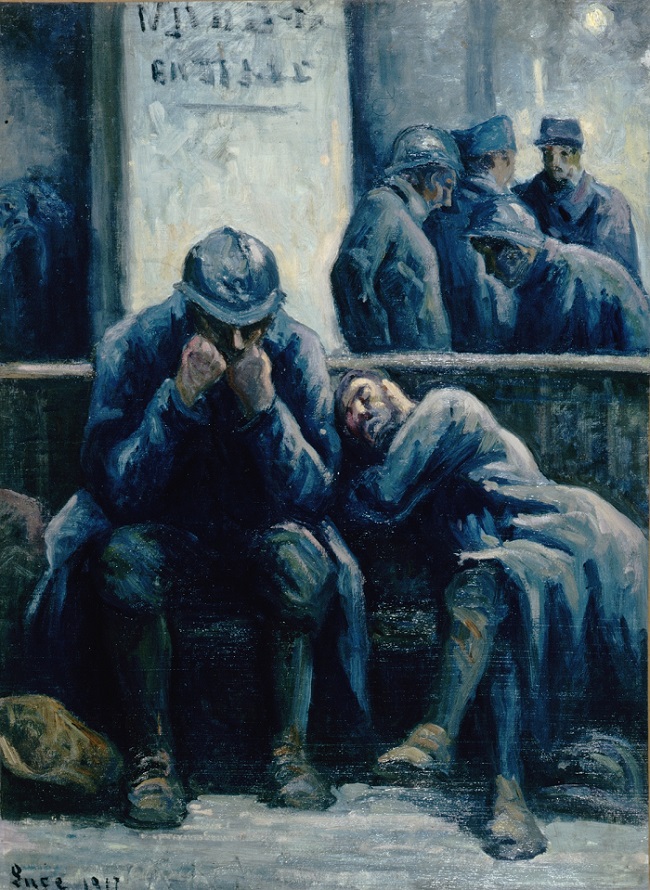 Maximilien Luce, “Gare de l’Est, les Poilus.” Oil on re-enforced paper on canvas, 1917. ©Ville de Mantes la Jolie, Musée de l’Hotel-Dieu. The poilus were the foot soliders conscripted by the French government to fight in World War I.
Maximilien Luce, “Gare de l’Est, les Poilus.” Oil on re-enforced paper on canvas, 1917. ©Ville de Mantes la Jolie, Musée de l’Hotel-Dieu. The poilus were the foot soliders conscripted by the French government to fight in World War I.
Text copyright Paul Ben-Itzak
Images courtesy Ville de Mantes la Jolie, Musée de l’Hotel-Dieu
First published on the Arts Voyager on March 29, 2012, this story is re-posted today with revisions to celebrate the upcoming exhibition Les temps nouveaux, Seurat à Matisse, opening October 16 at the Musée d’Orsay in Paris and migrating to the Museum of Modern Art in New York next spring. The exhibition’s through-line is the critic Felix Fénéon, whose artistic inclinations and anarchist tendencies made him a natural compagnon de route of Maximilien Luce (1858 – 1941). It was also Fénéon who invited Luce to organize his first personal exhibition in 1888, at the Revue Indépendante. See below for more on their connections, notably as detailed in Michel Ragon‘s 2008 “Dictionnaire de l’Anarchie,” published by Albin Michel. Like what you’re reading? Please make a donation to the Dance Insider & Arts Voyager today in dollars or Euros via PayPal by designating your payment to paulbenitzak@gmail.com , or write us at that address to learn how to donate by check.
Imagine that Pissarro didn’t die in 1903 but continued to live and work for 38 years, extending his explorations in the various streams of Impressionism. Then imagine that he decided to consecrate the force of his talent and energy to more depictions of the poor sap, the working stiff, the pour conscript sacrificed as cannon fodder in a wasteful war, and the social movements championing them. Imagine that his brilliant palette became more dense, retaining the sense of color values he learned from Camille Corot, the precision he picked up from Georges Seurat, and his native curiosity, then augmenting them with the lessons of the Fauves, of late Claude Monet and even Pierre Bonnard. Well, you don’t have to imagine this artistic extension of a life; Pissarro’s friend, pupil, compagnon de chevalet and fellow anarchist sympathizer Maximilien Luce embodied it. Imagine, now, that you could see the living proof.
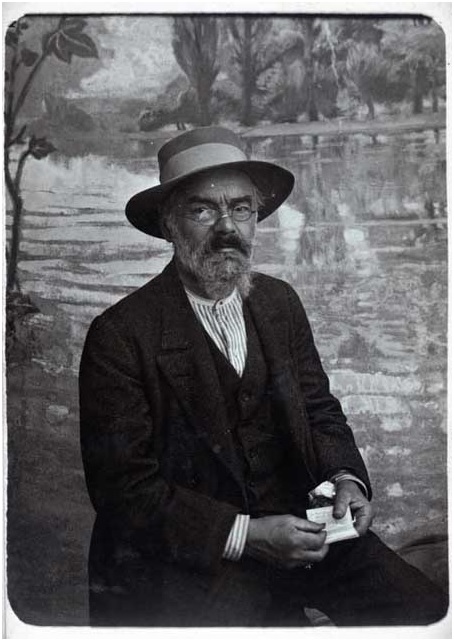
Portrait of Maximilien Luce. Silver print, 14 x 8 cm. Courtesy Ville de Mantes la Jolie, Musée de l’Hotel-Dieu.
The downside of the recent news that Christie’s had essentially unearthed an early study for Cezanne’s mythic “The Card Players” stashed away in a private collection was the realization that this watercolor, so critical for understanding the origins of the impulses behind such a seminal work, had been out of public view for nearly 60 years. While many conscientious private collectors readily lend their work to public expositions, nothing obligates them to do so. Once a work of art has been snapped up at auction by a private collector, nothing guarantees its continued public accessibility …. (That such work is also part of a public heritage is one reason that French law grants the State the right of ‘pre-emption’ on works up for public auction.) All the more reason to be grateful that Frederic Luce left a stunning 150 of his father’s works to the Parisian suburb of Mantes la Jolie and its museum the Hotel Dieu, now celebrating Luce with a new exhibition of 52 pieces, “Maximilien Luce, de l’esquisse (draft) au chef-d’oeuvre,” which follows the artist’s process from the draft to the oil painting, including by showcasing similar works in both forms. We’re privileged to be able to share some of this work here.
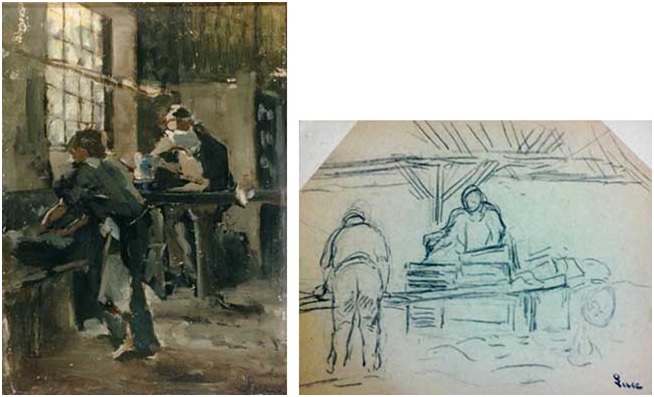 Left: Maximiien Luce, “Les Tanneurs.” Oil on paperboard. Right: Maximilien Luce, “Etude pour les Tanneurs.” Pencil on paper. Courtesy Ville de Mantes la Jolie, Musée de l’Hotel-Dieu.
Left: Maximiien Luce, “Les Tanneurs.” Oil on paperboard. Right: Maximilien Luce, “Etude pour les Tanneurs.” Pencil on paper. Courtesy Ville de Mantes la Jolie, Musée de l’Hotel-Dieu.
A brief biographical re-cap is perhaps in order to deepen your appreciation of the work represented here: Born in the 6th arrondissement of Paris in 1858, Luce was deeply marked by the Versailles repression of the Paris Commune in 1871, installing himself in 1887 in Montmartre, the foundry of the revolt, taking a room at 6 rue Cortot — the same address where a certain Erik Satie would move in 1890. (I didn’t realize this when, wandering onto this darkened, narrow, steep street one July 14 after watching the fireworks from Montmartre, I discovered the plaque noting Satie had lived there. Perhaps the city of Paris should add, “… and Luce.”) Did they overlap? Did Luce’s rebellious spirit inspire Satie in some of his own Dada-esque musical meanderings? The former soon put his into practice, collaborating with Emile Puget on his anarchist weekly Le Pere Peinard (contributing more than 200 engravings, as Michel Ragon notes in his entry for the painter in his “Dictionnaire de l’Anarchie,” published by Albin Michel in 2008) and participating in other similarly inclined journals, including La Revolte and L’Assiette au Beurre. During the infamous Trial of the 30 in 1894 (shortly after the assassination of French president Sadi Carnot by the anarchist Caserio), when, as Ragon recounts, “19 anarchist theorists were intentionally mingled with 11 thieves (supporters of the theory of individual reprise)” and charged with “criminal association” (a common charge applied today to suspected would-be terrorists). Luce shared a cell with art critic and Neo-Impressionist champion Felix Fénéon and Jean Grave, along with Sebastien Faure and Malatesta “the most celebrated theorist and anarchist militant of the debut of the 20th century.” All but one got off. (Ibid.) Echoing Gustave Courbet during his own imprisonment following the downfall of the Paris Commune, Luce made a series of etchings chronicling his imprisonment.
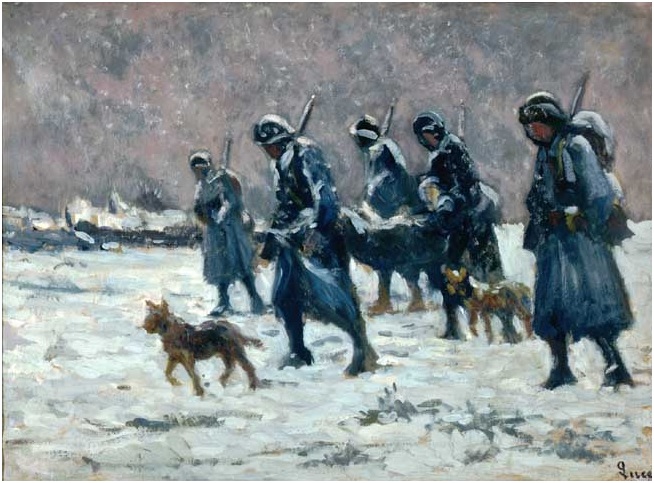 Maximilien Luce, “Transport d’un blessé.” Oil on canvas, 1916, ©Ville de Mantes la Jolie, Musée de l’Hotel-Dieu.
Maximilien Luce, “Transport d’un blessé.” Oil on canvas, 1916, ©Ville de Mantes la Jolie, Musée de l’Hotel-Dieu.
When the Neo-Impressionists’ chief theorist Seurat died on March 31, 1891, it was Luce, along with fellow neo-Impressionist Paul Signac and Fénéon, that Seurat’s widow charged with making an inventory of his studio. During the “Great War,” Luce painted a series of depictions of Parisian railway stations and soldiers on leave. (Such as the example featured above.) In 1920 he set up a studio on the rue de Seine, today still the central arterie of the Saint-Germain-des-Près gallery district. In 1935 he was elected president of the Society of Independent Artists. His wife Ambroisine died on June 7, 1940, at the family’s home in Rolleboise overlooking the Seine. Luce died in 1941 in his studio on the rue de Seine – not yet deported. When I read this I’m saddened by the realization that he died not knowing if the Nazis would ever leave Paris, like Jane Avril, cursing Hitler from her flat in the 15th arrondissement, and what would become of the world; our world is richer because of the legacy Luce left us — and the legacy his son Frederic left to the Hotel de Dieu museum in Mantes la Jolie. And what a potentially transformative legacy it is; when I toyed with the idea of moving from Paris to Mantes la Jolie in the mid-2000s because of its connection with Camille Corot (who instructed Pissarro and Morisot in color values from his studio on what is now the rue de Paradis, across the street from where I was living at the time), French Parisian friends warned me that it wasn’t safe because of the recent riots. But what better milieu to house and showcase the works of a conscious artist like Luce, with his concern for social turpitudes and answer of darkness with light?
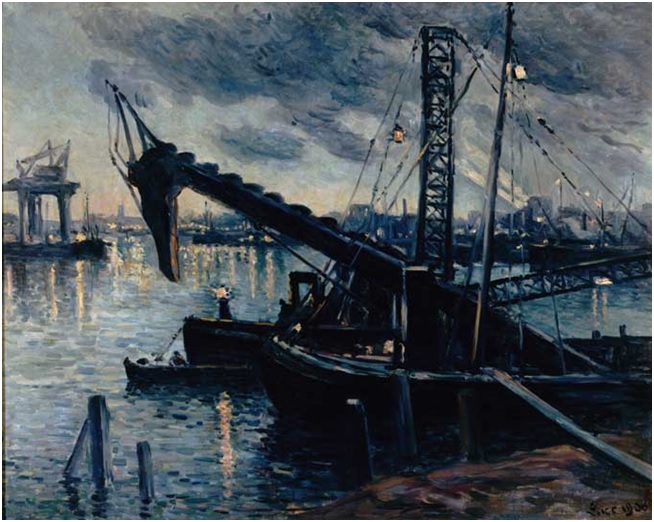 Maximilien Luce, “La drague a Rotterdam.” Oil on canvas. Courtesy Ville de Mantes la Jolie, Musée de l’Hotel-Dieu.
Maximilien Luce, “La drague a Rotterdam.” Oil on canvas. Courtesy Ville de Mantes la Jolie, Musée de l’Hotel-Dieu.
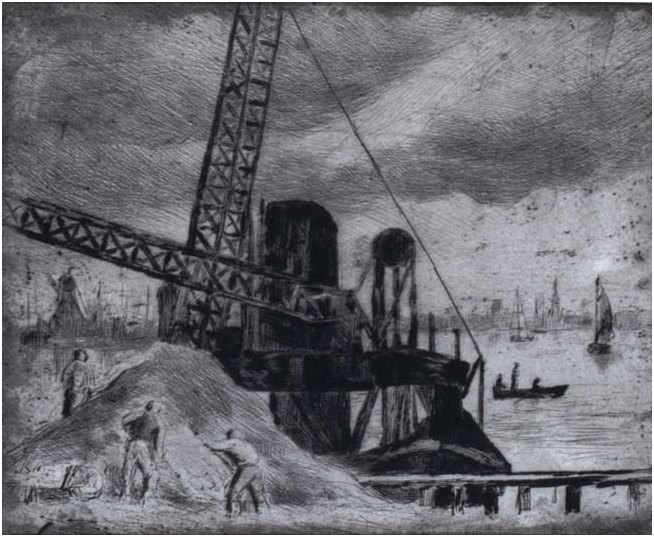 Maximilien Luce, “Chantier a Rotterdam.” Etching. Courtesy Ville de Mantes la Jolie, Musée de l’Hotel-Dieu.
Maximilien Luce, “Chantier a Rotterdam.” Etching. Courtesy Ville de Mantes la Jolie, Musée de l’Hotel-Dieu.
 Maximilien Luce, “Mers-les-Bains, les falaises.” Drawing in pencil and colored pencils on paper. ©Ville de Mantes la Jolie, Musée de l’Hotel-Dieu.
Maximilien Luce, “Mers-les-Bains, les falaises.” Drawing in pencil and colored pencils on paper. ©Ville de Mantes la Jolie, Musée de l’Hotel-Dieu.
 Maximilien Luce, “Mers-les-Bains, les falaises.” Oil on canvas,1903. ©Ville de Mantes la Jolie, Musée de l’Hotel-Dieu.
Maximilien Luce, “Mers-les-Bains, les falaises.” Oil on canvas,1903. ©Ville de Mantes la Jolie, Musée de l’Hotel-Dieu.
 Maximilien Luce, “La plage de Méricourt, Baignade.” Oil on canvas, undated. ©Ville de Mantes la Jolie, Musée de l’Hotel-Dieu.
Maximilien Luce, “La plage de Méricourt, Baignade.” Oil on canvas, undated. ©Ville de Mantes la Jolie, Musée de l’Hotel-Dieu.
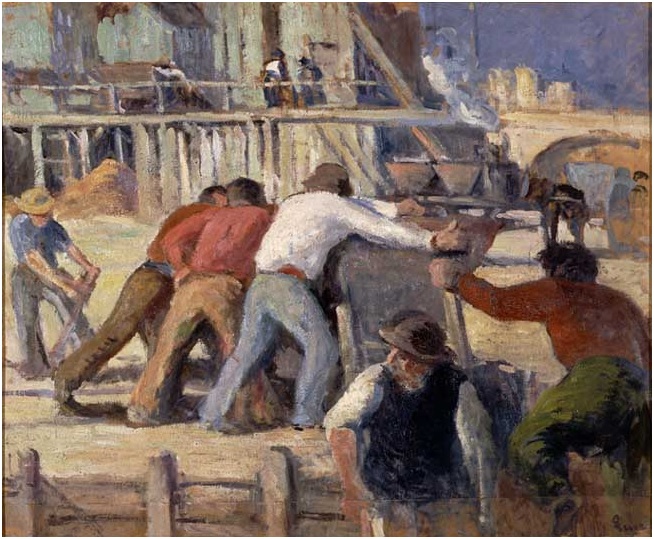 Maximilien Luce, “Travailleurs poussant un wagonnet.” Oil on paperboard, 1905. ©Ville de Mantes la Jolie, Musée de l’Hotel-Dieu.
Maximilien Luce, “Travailleurs poussant un wagonnet.” Oil on paperboard, 1905. ©Ville de Mantes la Jolie, Musée de l’Hotel-Dieu.
 Maximilien Luce, “Le fardier.” Oil on paperboard, undated. ©Ville de Mantes la Jolie, Musée de l’Hotel-Dieu.
Maximilien Luce, “Le fardier.” Oil on paperboard, undated. ©Ville de Mantes la Jolie, Musée de l’Hotel-Dieu.
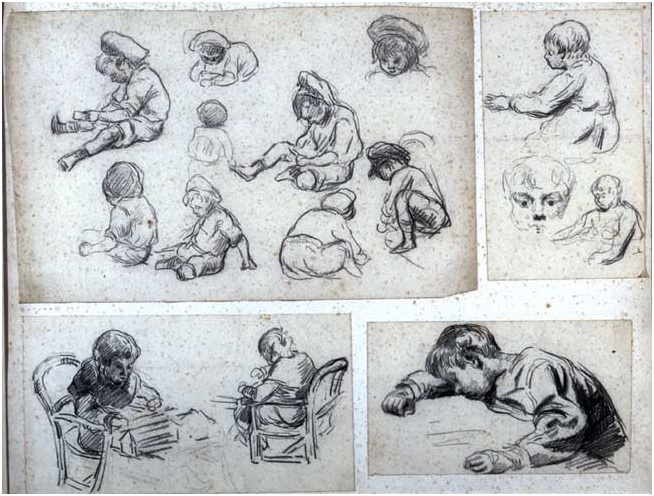 Maximilien Luce, “Etudes d’enfants.” Charcoal drawing, undated. ©Ville de Mantes la Jolie, Musée de l’Hotel-Dieu.
Maximilien Luce, “Etudes d’enfants.” Charcoal drawing, undated. ©Ville de Mantes la Jolie, Musée de l’Hotel-Dieu.
 Maximilien Luce, “La Ferme Vassard.” Oil on canvas, circa 1930. Courtesy Ville de Mantes la Jolie, Musée de l’Hotel-Dieu.
Maximilien Luce, “La Ferme Vassard.” Oil on canvas, circa 1930. Courtesy Ville de Mantes la Jolie, Musée de l’Hotel-Dieu.
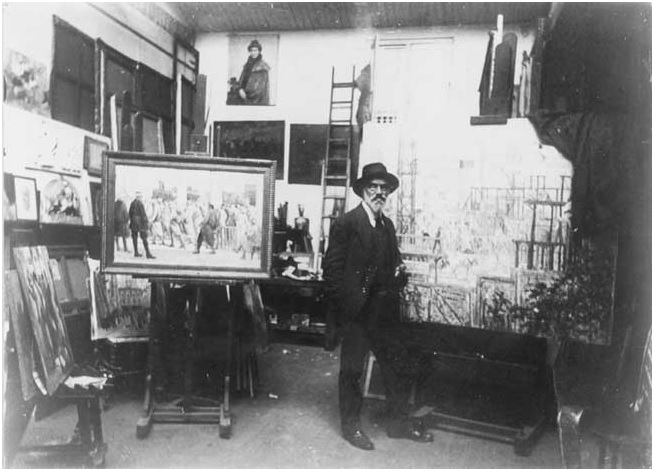 Luce in studio: Maximilien Luce in his studio. Courtesy Ville de Mantes la Jolie, Musée de l’Hotel-Dieu.
Luce in studio: Maximilien Luce in his studio. Courtesy Ville de Mantes la Jolie, Musée de l’Hotel-Dieu.

 Poster designed by Michèle Forgues and Federica Nadalutti, and courtesy Ateliers d’Artistes de Belleville.
Poster designed by Michèle Forgues and Federica Nadalutti, and courtesy Ateliers d’Artistes de Belleville. 

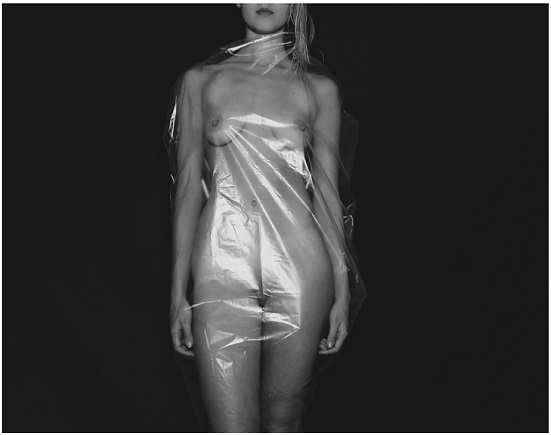
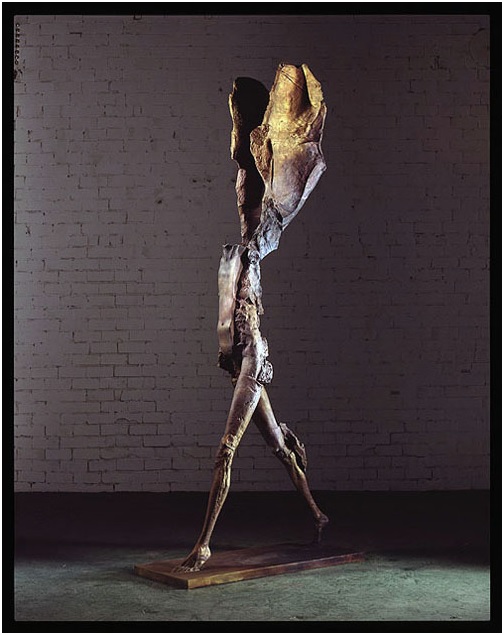
 Having caught his all-inclusive 2002 show at the Modern Art Museum of the City of Paris and reflected that, as with many artists (more recently, Wilfredo Lam and Le Courbusier, both revealed in over-abundance at the Pompidou Center), the oeuvre of Francis Picabia isn’t necessarily well-served by being shown in its entirety (the later works often resemble garish studies based on magazine photographs… as many were), I wasn’t particularly excited about Francis Picabia: Our Heads Are Round so Our Thoughts Can Change Direction, the monographic Picabia show running through March 19 at the Museum of Modern Art. That was before I saw the above, created in that seminal year of 1911, just one of the 200 works including 125 paintings featured — and definitely not included in the Paris exhibition. Francis Picabia (1879-1953), “Adam et Ève” (Adam and Eve). 1911. Oil on canvas, 39 3/8 × 31 7/8″ (100 × 81 cm). Private collection. © 2016 Artist Rights Society (ARS), New York/ADAGP, Paris. — Paul Ben-Itzak
Having caught his all-inclusive 2002 show at the Modern Art Museum of the City of Paris and reflected that, as with many artists (more recently, Wilfredo Lam and Le Courbusier, both revealed in over-abundance at the Pompidou Center), the oeuvre of Francis Picabia isn’t necessarily well-served by being shown in its entirety (the later works often resemble garish studies based on magazine photographs… as many were), I wasn’t particularly excited about Francis Picabia: Our Heads Are Round so Our Thoughts Can Change Direction, the monographic Picabia show running through March 19 at the Museum of Modern Art. That was before I saw the above, created in that seminal year of 1911, just one of the 200 works including 125 paintings featured — and definitely not included in the Paris exhibition. Francis Picabia (1879-1953), “Adam et Ève” (Adam and Eve). 1911. Oil on canvas, 39 3/8 × 31 7/8″ (100 × 81 cm). Private collection. © 2016 Artist Rights Society (ARS), New York/ADAGP, Paris. — Paul Ben-Itzak